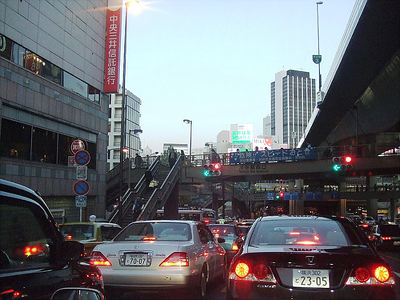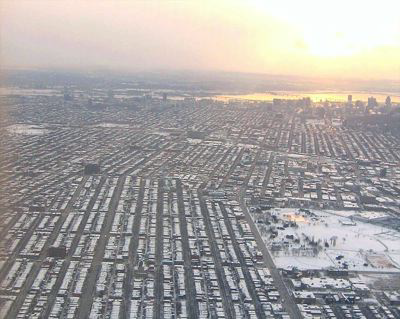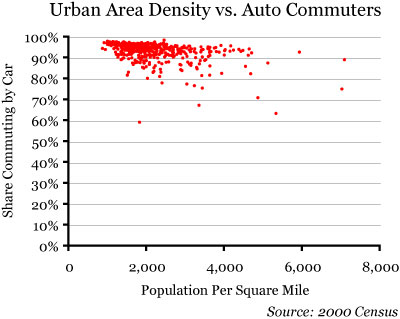No Light Rail in Vancouver!
Mayor Sullivan goes on to say that “it is not sustainable to continue stripping our agricultural land and forests to develop vast tracts of single family neighbourhoods.” There is something really spooky about a politician in the nation with one of the the lowest population densities in the world worrying about running out of land.

Tokyo, which is so dense that hardly anyone drives at all. Flickr photo by retardita.
You want high density, look at the Tokyo-
By comparison, Canada’s 2006 census reveals that 75 percent of its people live on just 1.2 percent of its land. The average density of these communities is less than 600 people per square mile. Since typical U.S. urban densities are about 1,000 to 7,000 per square mile, this suggests that Statistics Canada included lots of rural or unoccupied land in these zones.

This doesn’t threaten . . .
Put it this way. Canada has about 12.5 million households. If every single one of
them went out and bought a quarter-

. . . either this . . .
I know most Americans and even many Canadians think that Canada is mostly ice and
tundra with a thin livable area hugging the U.S. border where farmers are getting
overrun by urban development. According to Statistics Canada, 7.5 percent of Canada
is productive farmland, a little more than half of which is used for growing crops.
Moreover, both of these numbers have increased since 1981. Even if all 12.5 million
households build their suburban quarter-

. . . or this. Flickr photos by bjorkfansoph, damclean, and pmorgan.
Another 27 percent of the country is productive timberland. Since 90 percent of this is publicly owned, there is not much danger of it being subdivided.
But what about Mayor Sullivan’s greenhouse gas argument? A neighbor of mine here in Oregon has calculated that, when you count both manufacturing and disposal costs, a Prius actually uses more energy per mile than a Hummer. Some people dispute this finding, but the point is that the debate is far from simple.
What would happen if we did a lifetime analysis of Vancouver urban densities vs.
suburban densities? Especially if the urban density accounted for all the costs of
improving infrastructure to handle higher density infill? Does constructing 20-
These are complicated questions, but for Vancouver’s mayor they are not even at issue. Just as there is a supposed consensus behind antropogenic global warming, Mayor Sullivan wants us to believe there is a consensus that higher densities have lower environmental effects. He is wrong.
10
Trackback • Posted in Urban areas
Vancouver Mayor Promotes “Ecodensity”

From north of the border, the mayor of Vancouver BC, Sam Sullivan, wants to know why people aren’t talking more about “the link between increased urban density and the impact on our global ecology.” Uh, maybe because there isn’t one?
Oh, but there is, he says. “The science is very clear on the link between density
and the environment. Densification reduces urban sprawl. When people live closer
to where they work, they travel less often in carbon-
Simply getting people to change their light bulbs will not solve global warming, he argues. Instead, we have to pack more people in cities so they can be “sustainable.”
Let’s test his hypothesis. According to the 2000 census, Los Angeles is the densest urban area in the United States (and denser than any in Canada), and 89.5 percent of Los Angeles commuters usually drive to work. Just to the south, San Diego is only half as dense as L.A., and 90.9 percent of its commuters drive to work.
Atlanta is only half as dense as San Diego, and 93.5 percent of its commuters drive to work. And Lompoc California is about half as dense as Atlanta, and 94.4 percent of its commuters drive to work.
So doubling density gets a little more than 1 percent of commuters out of their cars.
Wowee zowie! Why hasn’t someone else thought of this? Of course, despite Mayor Sullivan’s
claim that “Vancouver has become the first city in North America to formally establish
an official policy of well-
San Jose’s urban-
Click on the chart to download an Excel spreadsheet with 2000 census data for more than 400 urban areas showing densities and the share of commuters who take cars, transit, or walk/bike to work.
My numbers may seem selective, but a more thorough review confirms there is only a weak correlation between density and driving. While many urban areas do have a smaller share of commuters driving to work than Los Angeles, they are not necessarily dense: the lowest share is in Ithaca, NY, whose density is about the same as Atlanta’s.
Reprinted from The Antiplanner
